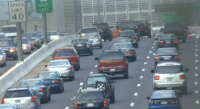Alliance Fuel-Efficiency Tips Ease Strain of Gas Price Surge
The Alliance to Save Energy News
Alliance Fuel-Efficiency Tips Ease Strain of Gas Price Surge
Does the sudden jump in gas prices have you jumpy as you head out on your summer vacation? Fuel-efficient driving and proper vehicle maintenance, as demonstrated in the Alliance to Save Energy’s fuel-efficiency videos, can keep more money in your pocket this summer and beyond.
“Gas prices have surged by about 15 cents a gallon in the past month according to AAA,” said Alliance to Save Energy President Kateri Callahan, “and the Alliance calculates that American households will spend some $3,325 to fuel their vehicles this year. So if you plan a road trip this summer, be sure to use our fuel-efficiency tips to maximize mileage and savings.”
Tips for Vehicle Maintenance
- Tune up. Fixing a car that’s out of tune or has failed an emissions test can improve its gas mileage by an average of 4%, saving about $77 a year. Fixing a serious maintenance problem, such as a faulty oxygen sensor in an older car, can improve your mileage by as much as 40%, or more than $1,200!
- Keep tires properly inflated to improve mileage by up to 3.3%, or about $57 a year, as under-inflated tires can lower mileage by 0.3% for every 1 psi drop in pressure in all four tires. Proper inflation also improves tire longevity – and driver and passenger safety. The U.S. Department of Energy (DOE) cautions not to rely on the pressure setting on the tire’s sidewall, but to consult your owner’s manual or look for a sticker on the driver’s side door jamb or in the glove box.
- Use the manufacturer’s recommended grade of motor oil or risk lowering your gas mileage by 1-2%, wasting up to $40 annually. DOE also advises looking for the phrase “Energy Conserving” on the American Petroleum Institute performance symbol to ensure that the oil contains friction-reducing additives.
- Get the junk out of the trunk! Remove unnecessary items in your vehicle’s trunk – an extra 100 pounds could reduce your mileage by up to 2%, wasting about $38 a year.
- Also nix a loaded roof rack, which can cut fuel economy by 5%, or about $93 per year.
Tips for Smart Driving
- Avoid aggressive driving. Speeding, rapid acceleration and rapid braking can lower gas mileage by 33% at highway speeds, wasting more than $925/year, and 5% around town, wasting about $93/year.
- Avoid speeding. Mileage usually decreases rapidly above 50 miles per hour. Each five mph over that speed is like paying another 24 cents per gallon.
- Avoid idling, which gets 0 miles per gallon, wasting a quarter to a half gallon of fuel per hour, depending on engine size and air conditioner use – yet it takes only a few seconds’ worth of fuel to restart your engine.
- Use cruise control. Using cruise control on the highway helps you maintain a constant speed and, in most cases, save gas and money.
- And don’t forget to engage the overdrive gear to reduce engine speed, which saves gas and reduces engine wear.
- Plan your trips. Combining errands into one trip saves not only time but money, too. Taking several short trips from a cold start each time can use twice as much fuel as one multipurpose trip covering the same distance with a warm engine.
- Beat the traffic. When possible, drive and/or commute during off-peak hours to avoid stop-and-go traffic. You’ll reduce stress as well as gas costs!
Tips for Smart Commuting
- Use a more fuel-efficient vehicle, if you have a choice, whenever possible.
- Consider alternatives to driving solo. Take advantage of carpools and ride-share programs to cut your weekly fuel costs by as much as half – and save wear on your car. Many urban areas allow vehicles with multiple passengers to use High Occupancy Vehicle, or HOV, lanes which are typically less congested, further improving your fuel economy. Carpooling twice a week with two others can save each of you about $144/year.
- Also consider telecommuting from home, if your employer permits it. Doing that just twice a week can save you more than $430/year.
- Look into public transit options, too. The American Public Transportation Association has links to information about public transportation in each state.
And Lastly…
- Find additional tips and resources on DOE’s fuel economy website.
Alliance to Save Energy Media Contacts
- Ronnie Kweller: 202-530-2203; rkweller@ase.org
- Monique O’Grady: 202-530-2217; mogrady@ase.org
STAY EMPOWERED
Help the Alliance advocate for policies to use energy more efficiently – supporting job creation, reduced emissions, and lower costs. Contact your member of Congress.
Energy efficiency is smart, nonpartisan, and practical. So are we. Our strength comes from an unparalleled group of Alliance Associates working collaboratively under the Alliance umbrella to pave the way for energy efficiency gains.
The power of efficiency is in your hands. Supporting the Alliance means supporting a vision for using energy more productively to achieve economic growth, a cleaner environment, and greater energy security, affordability, and reliability.
